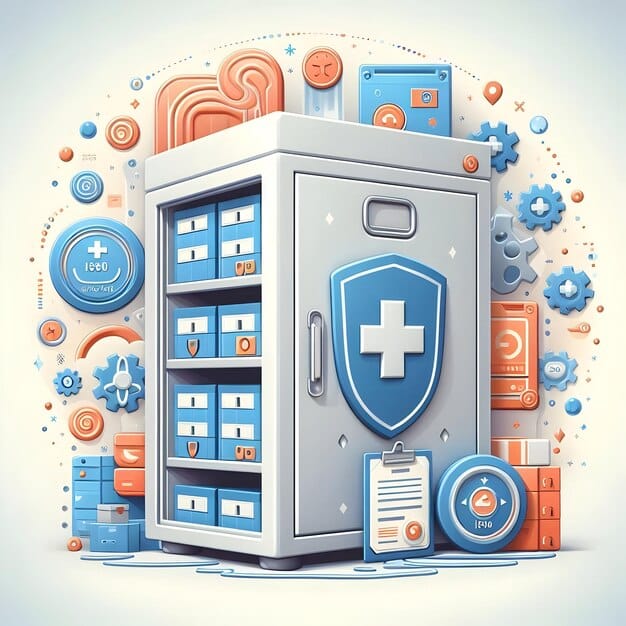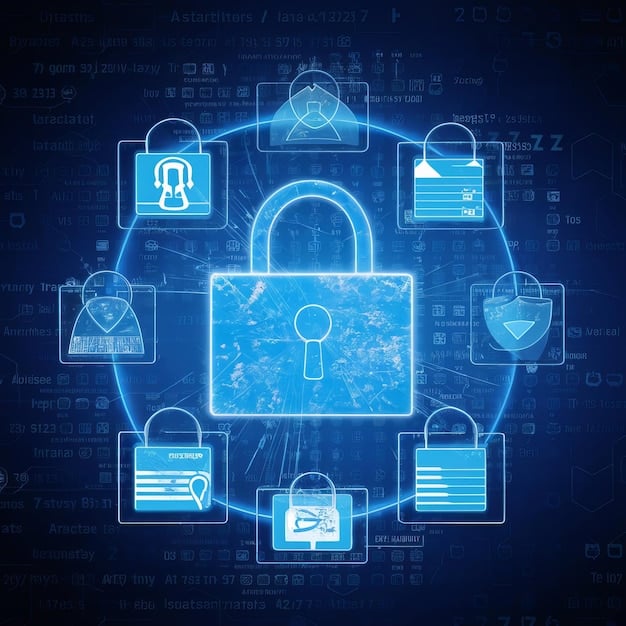Healthcare Cybersecurity Threats: 5 Steps to Protect Your Medical Data in 2025

Healthcare Cybersecurity Threats: 5 Steps to Protect Your Medical Data in 2025 focus on safeguarding sensitive patient information. These steps help healthcare organizations minimize risks and uphold patient confidentiality in an evolving digital landscape.
The healthcare sector is a prime target for cyberattacks due to the massive amounts of sensitive patient data it holds. As we approach 2025, the sophistication and frequency of healthcare cybersecurity threats demand a proactive and robust defense strategy.
This article outlines five critical steps that healthcare organizations can take to protect their medical data and ensure patient privacy against evolving cyber threats.
Understanding the Evolving Landscape of Healthcare Cybersecurity Threats
The digital transformation of healthcare has brought immense benefits, but it has also opened new avenues for cyber threats. Understanding the current landscape is crucial for preparing effective defense strategies.
Increased Sophistication of Attacks
Cybercriminals are constantly developing more sophisticated methods to breach healthcare systems. These include advanced phishing campaigns, ransomware attacks, and supply chain compromises.
Vulnerabilities in Connected Devices
The proliferation of internet-connected medical devices, such as patient monitors and diagnostic equipment, introduces additional vulnerabilities. These devices often lack robust security features, making them easy targets for hackers.
To address these evolving threats, healthcare organizations must adopt a multi-faceted approach that includes:
- Regular risk assessments to identify vulnerabilities.
- Employee training on cybersecurity best practices.
- Implementing advanced security technologies.
By staying informed and proactive, healthcare providers can better protect patient data and maintain the integrity of their services. Addressing healthcare cybersecurity threats effectively requires continuous vigilance and adaptation to new security challenges.

Step 1: Implementing a Robust Cybersecurity Framework
A solid cybersecurity framework is the foundation of any effective defense strategy. This involves establishing policies, procedures, and technologies that work together to protect sensitive data.
NIST Cybersecurity Framework
The National Institute of Standards and Technology (NIST) Cybersecurity Framework provides a comprehensive set of guidelines for managing cybersecurity risks. It consists of five core functions: Identify, Protect, Detect, Respond, and Recover.
HIPAA Compliance
Compliance with the Health Insurance Portability and Accountability Act (HIPAA) is essential for healthcare organizations in the U.S. HIPAA mandates specific security measures to protect patient data and imposes strict penalties for violations.
To implement a robust cybersecurity framework, consider the following steps:
- Conduct a thorough risk assessment to identify potential threats and vulnerabilities.
- Develop and implement security policies and procedures that align with industry best practices and regulatory requirements.
- Invest in security technologies such as firewalls, intrusion detection systems, and data encryption.
By implementing a well-defined cybersecurity framework, healthcare organizations can significantly enhance their ability to prevent, detect, and respond to healthcare cybersecurity threats. This proactive approach is crucial for long-term data protection and patient trust.
Step 2: Enhancing Employee Training and Awareness
Human error is a significant factor in many cybersecurity breaches. Enhancing employee training and awareness is crucial to minimizing this risk.
Regular Training Programs
Conduct regular training programs to educate employees about cybersecurity threats and best practices. These programs should cover topics such as phishing awareness, password security, and data handling procedures.
Simulated Phishing Attacks
Use simulated phishing attacks to test employees’ awareness and identify areas where additional training is needed. These simulations can help employees recognize and avoid real phishing attempts.
Effective employee training should also include the following elements:
- Clear and concise explanations of cybersecurity policies and procedures.
- Real-world examples of cybersecurity threats and their potential impact.
- Ongoing communication and reinforcement of key security messages.
Investing in employee training and awareness can create a culture of security within the organization, making employees an active part of the defense against healthcare cybersecurity threats. Informed and vigilant staff are essential for maintaining a strong security posture.
Step 3: Strengthening Access Controls and Authentication
Controlling access to sensitive data is critical to preventing unauthorized access and data breaches. Implementing strong access controls and authentication measures can significantly reduce this risk.
Multi-Factor Authentication (MFA)
Implement multi-factor authentication (MFA) for all critical systems and applications. MFA requires users to provide multiple forms of identification, such as a password and a one-time code sent to their mobile device.
Role-Based Access Control (RBAC)
Use role-based access control (RBAC) to limit access to data based on employees’ job functions. This ensures that employees only have access to the information they need to perform their duties.
Additional measures to strengthen access controls include:
- Regularly reviewing and updating user access privileges.
- Implementing strong password policies that require complex passwords and regular password changes.
- Monitoring user activity for suspicious behavior.
By strengthening access controls and authentication, healthcare organizations can better protect sensitive data from unauthorized access, mitigating the impact of healthcare cybersecurity threats. These measures are a vital part of a comprehensive security strategy.
Step 4: Implementing Data Encryption and Backup Solutions
Data encryption and backup solutions are essential for protecting data both in transit and at rest. These measures help ensure data confidentiality, integrity, and availability in the event of a cyberattack or other disaster.
Data Encryption
Encrypt sensitive data both in transit and at rest. Encryption scrambles data so that it is unreadable to unauthorized users. Use strong encryption algorithms and regularly update encryption keys.
Regular Data Backups
Perform regular data backups and store backups in a secure, offsite location. This ensures that data can be recovered quickly in the event of a data breach, ransomware attack, or other disaster.
Best practices for data encryption and backup solutions also include:
- Testing data backups regularly to ensure they are working properly.
- Implementing data loss prevention (DLP) tools to prevent sensitive data from leaving the organization.
- Ensuring that data backups are encrypted and protected from unauthorized access.
Implementing robust data encryption and backup solutions is a critical step in protecting patient data and ensuring business continuity in the face of healthcare cybersecurity threats. These measures are essential for maintaining trust and compliance.

Step 5: Monitoring and Incident Response Planning for Healthcare Cybersecurity Threats in 2025
Proactive monitoring and incident response planning are essential for detecting and responding to cybersecurity incidents quickly and effectively. This involves establishing procedures for identifying, containing, and recovering from cyberattacks.
Security Information and Event Management (SIEM)
Implement a security information and event management (SIEM) system to monitor network activity and identify suspicious behavior. SIEM systems collect and analyze log data from various sources, providing real-time visibility into potential security threats.
Incident Response Plan
Develop and maintain a comprehensive incident response plan that outlines the steps to be taken in the event of a cybersecurity incident. This plan should include procedures for identifying the scope of the incident, containing the damage, and restoring normal operations.
A well-prepared incident response plan should also include:
- Designated incident response team members and their roles.
- Communication protocols for internal and external stakeholders.
- Procedures for preserving evidence and conducting forensic analysis.
By implementing proactive monitoring and incident response planning, healthcare organizations can minimize the impact of healthcare cybersecurity threats and ensure a swift recovery. This proactive approach is crucial for maintaining patient safety and trust.
| Key Aspect | Brief Description |
|---|---|
| 🛡️ Cybersecurity Framework | Establish policies and technologies to safeguard data. |
| 🧑🏫 Employee Training | Enhance awareness to reduce human error risks. |
| 🔒 Access Controls | Implement MFA and RBAC to prevent data breaches. |
| 💾 Data Encryption & Backup | Protect data in transit and at rest, ensure quick recovery. |
Frequently Asked Questions
Key threats include ransomware attacks, phishing campaigns, insider threats, and vulnerabilities in connected medical devices, all of which can compromise sensitive patient data.
Employee training reduces human error, a significant factor in breaches. Educated employees recognize and avoid threats like phishing, strengthening the organization’s security.
Data encryption scrambles sensitive information, making it unreadable to unauthorized users, protecting it both during transit and while stored, ensuring confidentiality.
A cybersecurity framework provides guidelines for managing risks, including policies and technologies to protect data. It helps organizations prevent, detect, and respond to threats.
An incident response plan includes steps to identify, contain, and recover from incidents, with designated team members, communication protocols, and procedures for forensic analysis.
Conclusion
Protecting healthcare data in 2025 requires a comprehensive and proactive approach. By implementing a robust cybersecurity framework, enhancing employee training, strengthening access controls, encrypting data, and establishing effective monitoring and incident response plans, healthcare organizations can significantly reduce their risk of cyberattacks.
Staying vigilant and adapting to the evolving threat landscape is crucial for maintaining patient trust and ensuring the integrity of healthcare services. Addressing healthcare cybersecurity threats is an ongoing process that requires continuous effort and investment.





